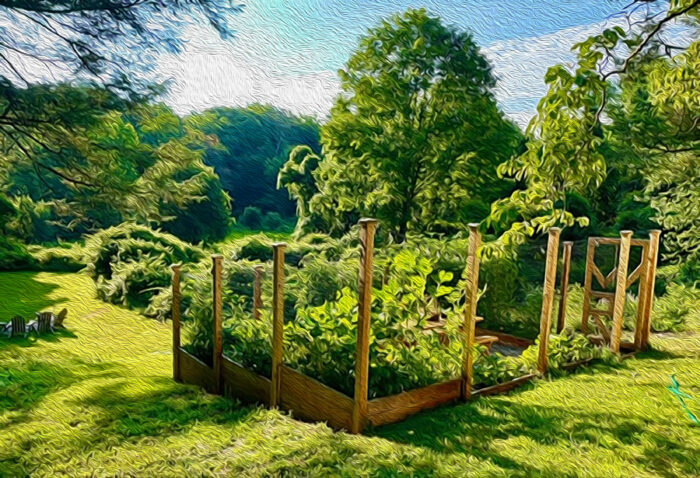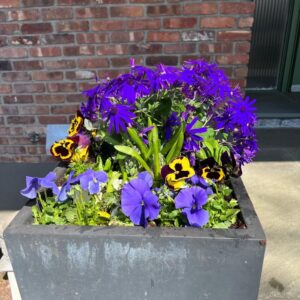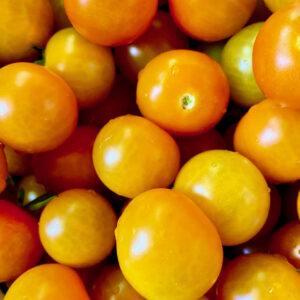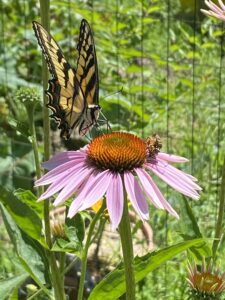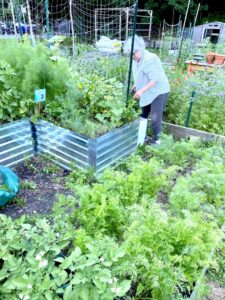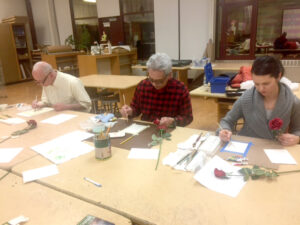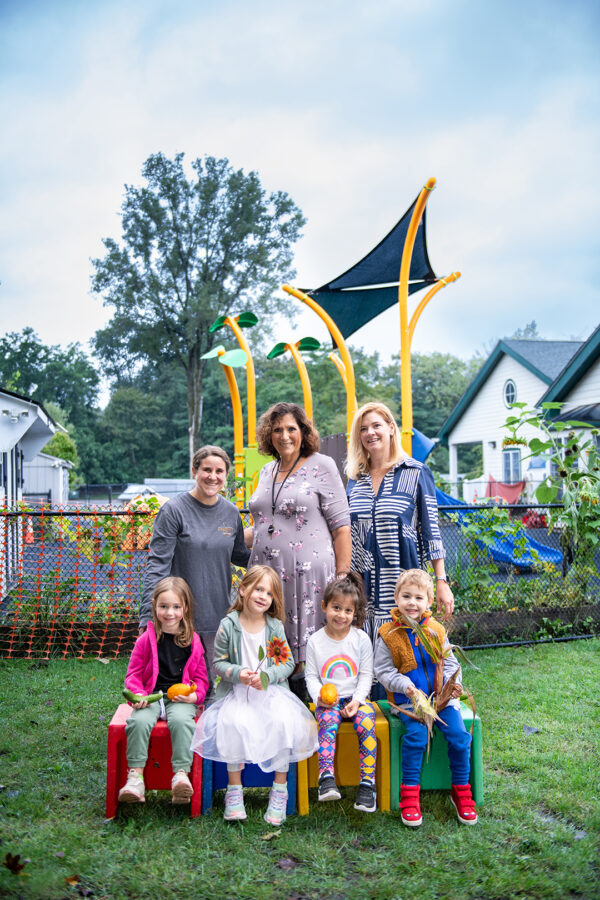
One of the most fraught moments of being a parent is entrusting the care of your precious child to someone else. A visit to the Mount Kisco Child Care Center (“the center”), which I fell in love with on my recent visit, can put any reluctant parent’s mind at ease, should they be lucky enough to make it off the long waitlist to enroll.
From the moment you walk into the center, you feel the warmth in this “home away from home.” Peeking into the infant rooms, where babies range in age from three months to 18 months, I can’t help but feel joy and giggle in response to several little ones who look and smile my way.
“It’s a beautiful thing to see the smiley babies every day,” says Executive Director Dawn Meyerski. “If I’m frustrated with work, all I need to do is spend an hour in the preschool and I remember why I do this.”
“It’s a lot of fun to work here,” says Victoria Rivera, infant supervisor, and head teacher. “I get to snuggle all the babies and it’s amazing to see the connection we make with each family and the difference we make, working as a team with the parents.”
In the toddler program, for those 18 months to three-years-old, the focus is on language acquisition, self-help skills, social skills, and, of course, potty training. Meyerski estimates that in the center’s history, they must have potty trained close to 7000 children.
The programs are designed with intention and thoughtfulness. For example, in the preschool classrooms, the three, four, and five-year-olds are purposefully combined so that their activities are geared towards where they are developmentally versus chronologically. So, if a three-year-old is ready for more advanced activities, they can pursue them, but if a four-year-old isn’t ready, they are not embarrassed since everyone in the class is doing different things.
The directors and teachers work together to support the children and families when needed. A social worker on staff helps families navigate more complex resource needs for special developmental services or subsidy reimbursements, as well as things like the death of a pet, a parent loses a job or becomes sick, really anything that the family encounters.
The belief at the center is that for the child to succeed, the whole family needs to be supported. The before and after school programs provide a true safety net for working parents, letting parents feel secure that their child has a place to go after school while they are at work, even when school lets out early for a snow day. For vacations, the center offers full day programming so parents can work. In the summer, they provide full day summer camp programming, including martial arts, swimming, field trips, and more.
Throughout the pandemic, the center stayed open, easing the burden for many working parents while their school age children completed remote learning at the center. “We had 40 kids from seven different school districts using all different learning platforms. Those after-school teachers were incredibly adaptive…
“We made it happen,” says Meyerski.

Feed Me Fresh
One of the biggest reasons people choose the center is the food services. Mostly everything is prepared on site in the kitchen and they try to use as little processed food as possible.
In addition to feeding the kids, the center encourages the children to understand where their food comes from with their signature Feed Me Fresh program, a comprehensive garden-to-table nutrition education curriculum. All the classrooms have their own raised bed gardens where they plant and harvest the same food the kitchen uses to make their lunches. The center combines gardening teaching units with cooking classes and related activities. If they are harvesting zucchini, they will come in and make zucchini boats. Later, when zucchini shows up on the lunch menu, they recognize it and are far more willing to eat it.
“One of my favorite gardens that we plant is the three sisters garden,” says Meyerski. “The school age kids plant corn, the toddlers plant squash, and the preschoolers plant green beans. They are companion crops that grow better together than they do apart. We use this to talk about the importance of working together. I love it because it’s symbolic of who we are and how we support each other.”
When the kids are on the playgrounds, they walk right past and pick snap peas off garden beds and eat them. In a display of pride and ownership, they independently check on the status of their growing vegetables.
“What I love best about it,” says Meyerski, “in a world where you can have anything you want in thirty seconds, where instant gratification is so real, you cannot make a carrot grow any faster than a carrot grows. They have to slow down and nurture it.”
Funding the Center
About half of the enrolled children pay the full tuition to attend the center. Tuition for the infant program runs nearly $2500 per month. The actual cost of care for infants and toddlers exceeds the tuition charged, but charging a higher rate would price out most families. The other half of the children are on scholarship, based on their family income. The center works with the Department of Social Services for some subsidies, but the bulk of their funding comes from donations. The center runs as a nonprofit and raises funds to support the children. It is their critical fundraising efforts that allow them to offer quality childcare to middle and low-income earning families, providing peace of mind to working parents.
Naturally, one of their biggest fundraising campaigns, the annual Feed Me Fresh gala, incorporates the center’s focus on fresh food. This year’s event took place at Ivanna Farm on September 23rd. This event started 19 years ago with incredible support from local restaurants who donate an evening of delicious, fresh, and inventive food. “Despite the rain this year, everyone showed up!” reported Paula Backer, the center’s Director of Development. All the restaurants, our sponsors and all our amazing supporters, came out despite the weather. We really felt the love of the community coming together around us in support of our families and what we do. It was beautiful and the food from our restaurant supporters was the best ever!”

Meaningful Lessons to Remember
Despite their newest challenge of finding enough qualified teachers in the current labor shortage post pandemic, the center provides amazing programming.
A good teacher knows that kids learn best when they learn about things that are meaningful to them, so the staff at the center strives to create memorable lessons. If the kids are eating pizza for lunch, they will follow up with a walk down to the local pizza parlor for a social studies lesson about their community. Upon their return to the center, they will set up a pizza parlor and sell slices for a dollar apiece and learn about fractions as they cut the pie. As they make the menu, they learn their letters, and when they make the pizza and learn how to make cheese melt, they learn about science. Something as simple as pizza can prompt multiple learning opportunities.
This year, the center is collaborating with the STEM Alliance to bring in STEM programming for the preschool classes. The center is very grateful for a grant received due to the support of New York State Assemblyman Chris Burdick for in-house STEM training for the center’s teachers for next year.
Meyerski hopes to bring back their cherished intergenerational programming, in which senior citizens from My Second Home, a senior living provider, used to rent space at the center and interact several times a day with the children in organized activities. The program has not resumed after it was paused for safety reasons during the pandemic.
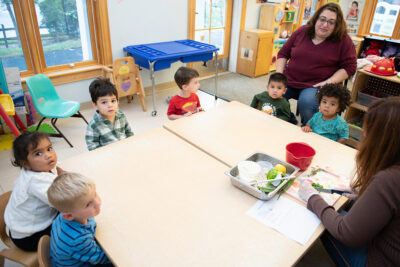
Extended Family
“MKCCC is a special place and I consider the adults who work there extended family,” says parent Stacey Cafaldo. “My daughter lost her confidence at another center and from the moment she started at MKCCC they made her feel strong and assertive. They reignited her love for learning and brought out the absolute best in her. Their unconditional assurance and support helps each kid develop into the best version of themselves possible.”
“It’s like a family here,” says toddler supervisor and head teacher Vanessa Kardos, who has worked at the center 21 years. “My first group of children are walking across the stage graduating college right now – seeing them become these amazing, mature and wonderful adults coming back as volunteers sometimes makes me so proud that I laid that foundation for them. Between the family feeling here and having so much fun with 2-year-olds all day and the love we get from them when we walk into a classroom, it makes you forget anything negative in the world. You’re giving so much love and getting so much love all day long.” For more information about the center, please visit mkccc.org.
